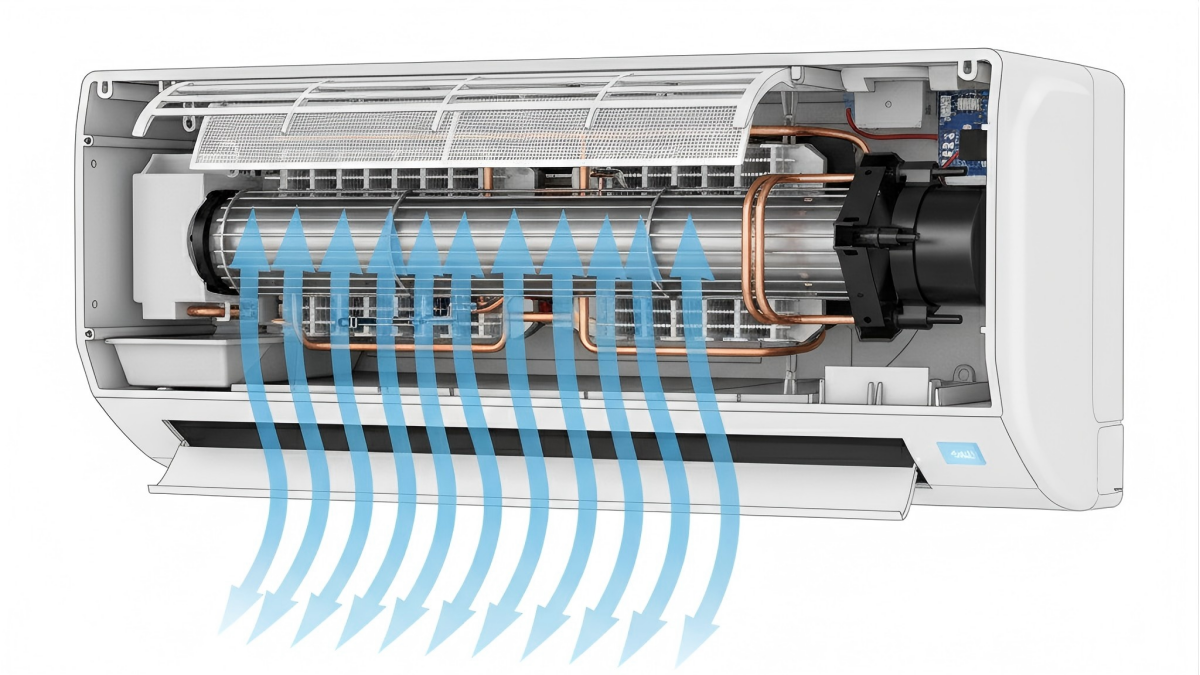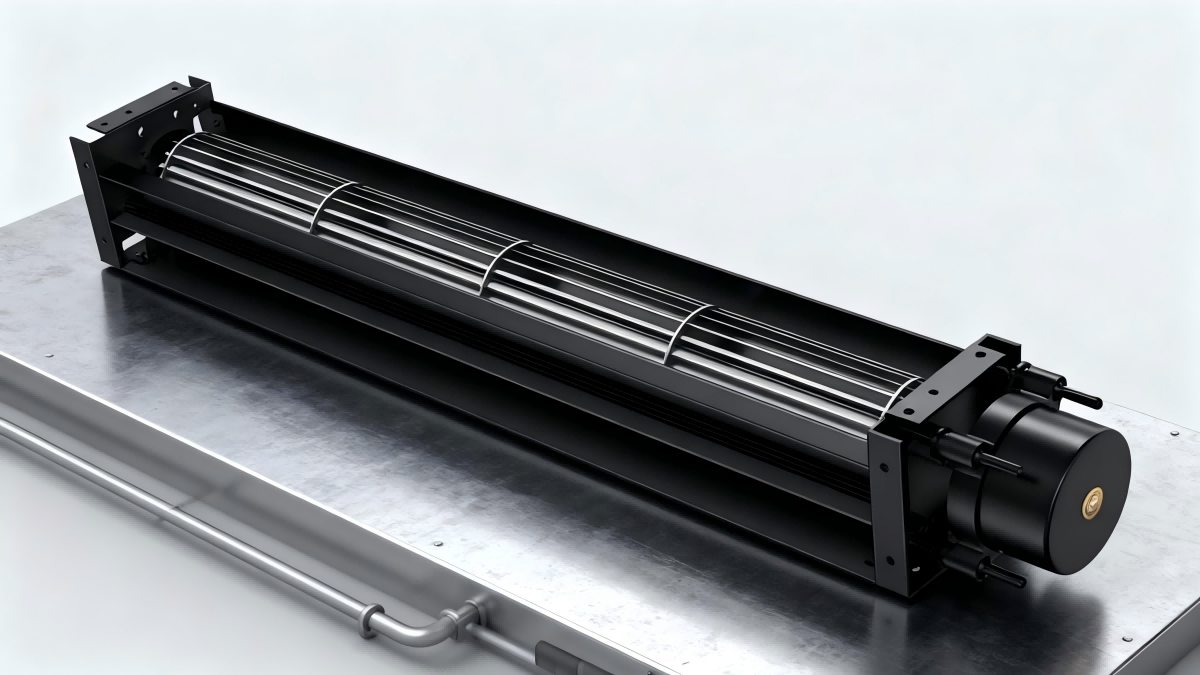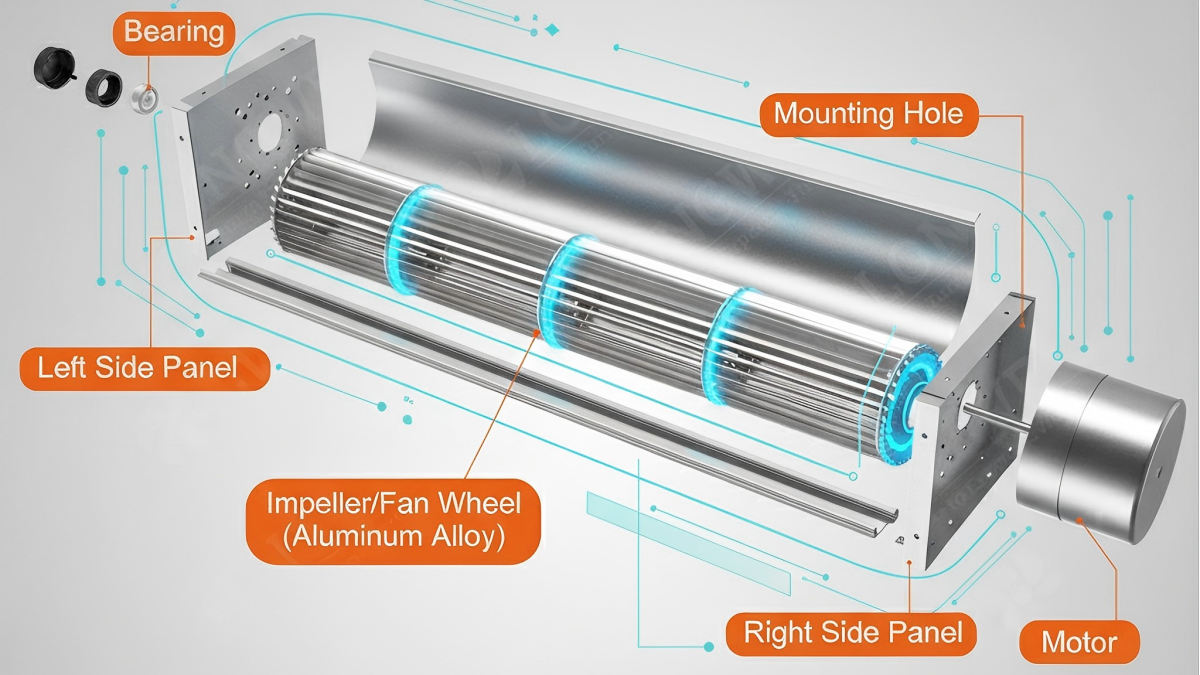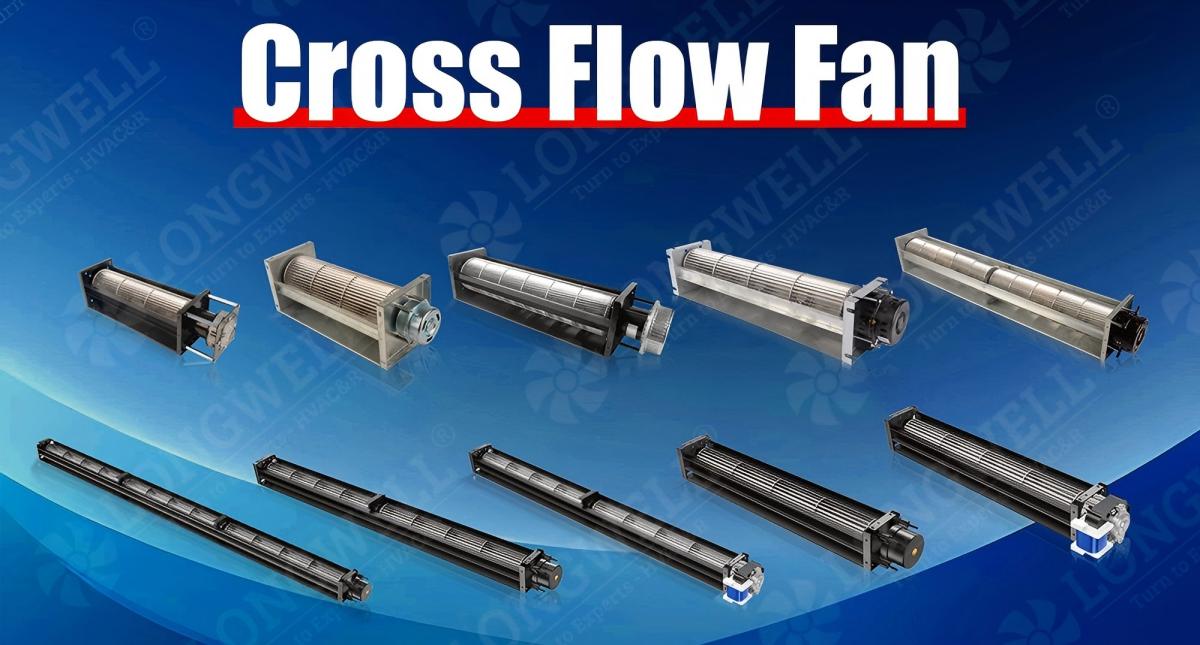Air conditioner cross flow fan

A cross flow fan is a special type of fan inside your air conditioner that helps move air across the cooling coils. You rely on this fan to spread cool air evenly throughout your room. When the fan works efficiently, your air conditioner cools the space faster and keeps noise levels low. Smart blade designs and advanced motors make the fan quieter and help maintain a comfortable indoor climate. Understanding this part helps you see how your AC can provide better comfort and save energy.
Key Takeaways
Cross flow fans provide smooth, even airflow, ensuring your room cools uniformly and prevents hot or cold spots.
These fans operate quietly, making them ideal for bedrooms and offices where noise reduction is important.
Using a cross flow fan can save energy, with potential savings of up to 30% in large spaces and 15% in data centers.
Regular maintenance, like cleaning and lubrication, extends the lifespan of your cross flow fan and keeps your air conditioner efficient.
Choosing a reputable brand like LONGWELL ensures high performance, durability, and excellent customer support for your air conditioning needs.
Cross Flow Fan Basics

What Is a Cross Flow Fan
A cross flow fan, sometimes called a tangential fan, is a special type of fan you find in many air conditioning systems. This fan uses a long, round impeller with many small blades. The shape of the fan is usually slim and rectangular, which helps it fit into tight spaces inside your AC unit. You can install this fan either horizontally or vertically, giving you more flexibility when setting up your air conditioner.
You get a smooth, even airflow from a cross flow fan.
The fan draws air in from one side and pushes it out across its length, creating a wide stream of air.
This design helps prevent hot spots and keeps the temperature steady in your room.
The fan works well in compact spaces because of its long, rectangular shape.
How It Works
The cross flow fan moves air in a unique way. Air enters the fan through the side intake. The spinning blades create a centrifugal force that pushes the air across the width of the fan. As the air moves, it forms a smooth, laminar flow with very little turbulence. The air then exits tangentially from the opposite side, spreading evenly throughout the space.
Tip: This airflow pattern is different from other fans. Axial fans push air straight along the shaft, while centrifugal fans move air outward in a radial direction. A cross flow fan creates a wide, even stream of air, which is perfect for cooling large surfaces or rooms.
Key Features
You will notice several important features when you look at a cross flow fan:
Feature | Description |
|---|---|
Tangential Airflow | Produces a smooth, even flow of air across the fan’s length, which helps cool your room evenly. |
DC Motor Efficiency | Uses energy-saving motors that run quietly and let you control the speed easily. |
Impeller Design | Has many small, evenly spaced blades that form a cylinder, giving you extended airflow. |
Compact Design | The slim, long shape fits well in tight spaces, like inside air conditioners or electronics. |
The streamlined casing of the fan helps reduce noise and improves airflow efficiency. You can enjoy a quieter and more comfortable environment because of this design. LONGWELL, a leading manufacturer of high-efficiency ventilation fans, uses advanced technology to make sure their fans deliver strong performance, energy savings, and reliable operation. Their fans stand out for high efficiency, energy conservation, and robust stability, making them a smart choice for your air conditioning needs.
Benefits

Uniform Airflow
You want your air conditioner to cool every part of your room evenly. A cross flow fan helps you achieve this by moving air perpendicularly across its axis. This design lets the fan pull air from one side, speed it up through the impeller, and push it out the other side, all in a single plane. Because of this, you get a steady and even airflow across the entire space. This uniform distribution is important for comfort and for preventing hot or cold spots in your room.
Note: Air conditioning systems use several methods to measure and control airflow distribution. Here are some common techniques:
Technique | Description |
|---|---|
Static Pressure Testing | Measures pressure differences in ductwork to find and fix airflow issues. |
Airflow Measurement | Uses tools like anemometers to check airflow rates for even distribution. |
Damper Adjustment | Adjusts dampers in ducts to balance airflow. |
Fan Speed Control | Changes fan speeds to reach the desired airflow. |
Quiet Operation
You may notice that your air conditioner runs quietly when it uses a cross flow fan. The special design of this fan reduces turbulence and spreads air smoothly, which keeps noise levels low. Many people prefer this type of fan for its quiet performance, especially in bedrooms or offices where silence matters.
The cross-flow design helps minimize noise.
The fan draws air from the sides and pushes it out evenly, which also keeps things quiet.
Compared to other fans, cross flow fans are known for low noise levels.
Fan Type | Noise Level Comparison |
|---|---|
Cross Flow | Preferred for low noise |
Axial | Typically quieter than centrifugal |
Centrifugal | Generally noisier than axial fans |
Energy Efficiency
You save energy when you use a cross flow fan in your air conditioner. This fan works efficiently in many settings, from large commercial spaces to data centers. For example, replacing traditional blowers with cross flow fans can save up to 30% energy in big buildings and 15% in data centers. Factories can see about 20% savings.
Application | Energy Savings | Description |
|---|---|---|
Large Commercial Spaces | Up to 30% | Improves air quality and comfort, meets green building standards. |
Factories and Plants | 20% | Cools machinery, keeps temperatures stable, prevents downtime. |
Data Centers | 15% | Maintains stable temperatures with less power, supports sustainability. |
Modern cross flow fans, like those from LONGWELL, use EC motors and smart controls. These features help you manage energy use by adjusting fan speed to match your needs. EC motors also reduce energy loss and keep the fan efficient, even at lower speeds. Smart controls let you monitor and adjust performance in real time, which lowers costs and helps the environment.
Comparison

Cross Flow Fan vs. Axial Fan
You may wonder how a cross flow fan compares to an axial fan. Both types move air, but they do so in different ways. The table below shows the main differences:
Feature | Cross Flow Fans | Axial Fans |
|---|---|---|
Airflow Direction | Perpendicular to the intake | Parallel to the axis of rotation |
Airflow Pattern | Wide, uniform airflow across the outlet | Focused, direct airflow |
Design | Elongated, cylindrical impeller with curved blades | Circular housing with multiple radial blades |
A cross flow fan spreads air evenly across a wide area. An axial fan pushes air straight ahead in a focused stream. You often see axial fans in places where you need to move air quickly in one direction, such as in window fans or cooling towers.
Cross Flow Fan vs. Centrifugal Fan
When you compare a cross flow fan to a centrifugal fan, you notice differences in both airflow and noise. Cross flow fans create smooth, even airflow at lower pressure. Centrifugal fans produce directional airflow and work well in high-pressure situations.
Fan Type | Airflow Pattern | Efficiency Characteristics |
|---|---|---|
Centrifugal Fans | Directional and less uniform | Higher energy use, best for high-pressure needs |
Cross-Flow Fans | Even and widespread at lower pressures | Use less energy, ideal for low-pressure applications |
You will also hear a difference. Cross flow fans usually run much quieter than centrifugal fans. The smooth airflow from a cross flow fan means less turbulence and less noise. Most cross flow fans in air conditioners make between 30 and 60 decibels of noise. At the lower end, this is as quiet as a library. At the higher end, it sounds like a normal conversation. Centrifugal fans often sound louder because their design creates more turbulence.
Cross flow fans: 30–60 dB (quiet to moderate)
Centrifugal fans: often louder due to higher turbulence
Use Cases
You should choose the right fan for your needs. Use a cross flow fan when you want even, gentle airflow and quiet operation. These fans work best in air conditioners, air curtains, and electronics cooling. Axial fans fit well in situations where you need to move a lot of air in a straight line, such as in exhaust systems or cooling towers. Centrifugal fans are best for high-pressure jobs, like ducted HVAC systems or industrial ventilation.
Tip: For home air conditioners, a cross flow fan gives you quiet, even cooling. For large buildings or factories, centrifugal fans handle higher pressure and larger spaces.
Applications and Care

Where Used in ACs
You often find cross flow fans in many types of air conditioning systems. These fans work especially well in split-type air conditioners. They help move air inside the indoor unit, making sure cool or warm air spreads evenly across the room. Many offices, hotels, and commercial buildings use these fans to keep the air comfortable for everyone. Ductless wall-mounted units also rely on this fan design to deliver steady airflow without taking up much space.
Split-type air conditioners
Ductless wall-mounted AC units
Office and hotel indoor units
Maintenance Tips
You can keep your air conditioner running smoothly by taking care of the fan. Regular cleaning is important. Wipe the fan’s surface with a damp cloth to remove dust. Make sure nothing blocks the air inlet or outlet. Lubricate the fan’s bearings to reduce friction and noise. Clean your fan every few months because dust and dirt can build up quickly. Use a soft brush or a vacuum for cleaning. Always turn off the power before you start.
Tip: Good maintenance helps your fan last longer and keeps your air conditioner working efficiently.
Longevity and Issues
A cross flow fan in an air conditioner usually lasts between 5 and 10 years. With regular care, it can last even longer. Some common issues can affect how long your fan works. The table below shows what to watch for:
Issue | Description |
|---|---|
Electrical Supply Stability | Power surges or voltage changes can overheat the motor. |
Bearing Condition | Lack of lubrication can cause resistance and failure. |
Contaminant Exposure | Dust and moisture can block movement and damage the motor. |
Motor Load | Imbalanced parts can wear out the motor faster. |
Ambient Temperature | High heat or cold can cause extra stress or condensation. |
Maintenance Practices | Skipping cleaning or checks can lead to early problems. |
LONGWELL stands out for its strong focus on research and development. The company uses advanced EC motor technology to improve energy efficiency and airflow control. LONGWELL’s products meet high standards, with certifications like ISO9001, ISO14001, and CE. You also get global technical support, making LONGWELL a trusted choice for reliable fan solutions.
You benefit from using a cross flow fan in your air conditioner because it spreads air evenly, keeps noise low, and saves energy. Choosing the right fan improves your comfort and helps your AC work better. When you pick a reputable brand like LONGWELL, you get extra advantages:
Advantage | Description |
|---|---|
Quiet Operation | Fans run quietly, perfect for homes and offices. |
High-Volume Airflow | Delivers strong airflow, lowering energy costs. |
Even Flow Distribution | Keeps room temperature steady and comfortable. |
Compact Size | Fits easily into different devices. |
Durability | Built to last, reducing maintenance. |
Customer Support | Offers help before and after your purchase. |
A well-designed fan boosts airflow and lowers energy use.
Good installation and regular cleaning keep your AC working at its best.
FAQ
What makes a cross flow fan different from other fans?
You get a wide, even airflow from a cross flow fan. The fan uses a long, slim shape and many small blades. This design helps cool your room evenly and quietly.
How often should you clean your air conditioner’s cross flow fan?
You should clean the fan every three to six months. Dust and dirt can build up quickly. Regular cleaning helps your air conditioner work better and last longer.
Can you replace a cross flow fan by yourself?
You can replace the fan if you have basic tools and follow safety steps. Always turn off the power first. If you feel unsure, ask a professional for help.
Why does your air conditioner make less noise with a cross flow fan?
The fan’s design reduces turbulence and spreads air smoothly. You hear less noise because the airflow stays steady and even. This makes your room more comfortable.
See Also
Selecting The Ideal Cross Flow Fan For Your Needs
Understanding Energy Efficiency Of Cross Flow Fans In Ventilation
Addressing Cooling Issues In Compact Areas With Cross Flow Fans
Maximizing Performance And Energy Efficiency With Axial Fans